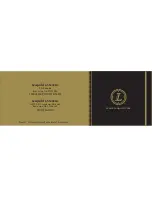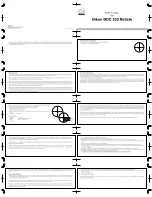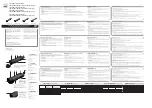
4
How To Set Up
Note: We recommend assembling your telescope for the first time in the daylight or in a lit room so
that you can familiarize yourself with assembly steps and all components.
• Open the tripod until the tripod spreaders are fully extended. Put the accessory tray in place
and turn it clockwise until stable. To set the tripod height, turn the pressure fitting on each leg
counterclockwise until loose. Extend or retract the leg to the desired setting, then tighten the
pressure fitting until snug.
• Thread the panhandle clockwise onto the tripod head.
• Set the optical tube assembly on the tripod head and align the tab on the bottom of the telescope
tube with the slot in the tripod head. Thread the front tension wheel until snug, then tighten the side
tension thumbscrew. Be careful not to over-tighten either screw.
• Insert the diagonal into the focuser and secure it by tightening the thumbscrews.
• Slide the red dot viewfinder into the finder bracket that is already mounted on the telescope tube.
• Place your chosen eyepiece into the diagonal. We recommend starting with the 20mm because it will
provide the widest field of view.
Using Your Telescope:
Put the 20mm eyepiece into the focuser to get the widest field of view. This wider field of view will
make it easier to locate and track objects. Use the panhandle to move the scope up, down and side to
side until your target comes into view in the eyepiece. It is important to remember that the rotation
of the Earth means objects will move out of your eyepiece fairly quickly. Once you have found and
focused on your desired target, you can track it as it journeys across the night sky using the panhandle.
To get a closer look at an object, take out the 20mm
eyepiece and replace it with the 12.5mm eyepiece.
This will increase the magnification from 30x to 48x.
Note: Terrestrial objects will appear reversed due to the
optical setup. This rotation is perfectly normal for a refractor using a standard diagonal, and it will
not affect astronomical viewing.
Cleaning:
Your telescope is a precision optical device and keeping the optics free of dust and dirt is crucial for
optimal performance. To clean the lenses (objective and eyepiece) use only a photo-grade soft brush
or a lint-free cloth, like a microfiber cloth. Do not press down too hard while cleaning, as this might
scratch the lens. If necessary, the cleaning cloth can be moistened with an optical glass cleaning fluid
and the lens wiped clean using very little pressure.
The eyepiece is NOT waterproof so do not spray
fluids directly onto the glass or dip it in water. Never use harsh detergents! After you have finished
cleaning an eyepiece, allow it to fully dry before storing.
Make sure your telescope is always protected against dust and dirt.
After use, leave it in a warm room to dry off before storing.
Troubleshooting Guide:
Problem
Solution
No picture
Remove dust protection cap.
Blurred picture
Adjust focus using focus wheel.
No focus possible
Wait for temperature to balance out.
Bad quality
Never observe through a glass surface such as a window.
Focal Length Eyepiece
Magnification
600mm
20mm
30x
600mm
12.5mm
48x
Summary of Contents for STAR50APP
Page 15: ...15 Notes ...

































